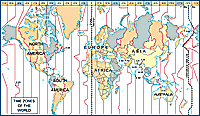Daylight Saving Time

A trip around the world reveals that time isn't a synchronized science
by John Gettings and Borgna Brunner
 Map of world time zones – full size U.S. Daylight Saving Time Schedule
Related Links
|
At 2 a.m. on March 13, 2016, Americans will turn their clocks ahead one hour, marking the beginning of Daylight Saving Time (DST).
The federal law that established "daylight time" in the United States does not require any area to observe daylight saving time. But if a state chooses to observe DST, it must follow the starting and ending dates set by the law. From 1986 to 2006 this was the first Sunday in April to the last Sunday in October, but starting in 2007, it is observed from the second Sunday in March to the first Sunday in November, adding about a month to daylight saving time. (See: New Federal Law.)
No More Sunlight in Arizona and Hawaii
Arizona (with the exception of the Navajo Nation) and Hawaii and the territories of Puerto Rico, Virgin Islands, Guam, and American Samoa are the only places in the U.S. that do not observe DST but instead stay on "standard time" all year long. And if you've spent any time in the sweltering summer sun in those regions you can understand why residents don't need another hour of sunlight.
The Dawning of DST in Indiana
Until April 2005, when Indiana passed a law agreeing to observe daylight saving time, the Hoosier state had its own unique and complex time system. Not only is the state split between two time zones, but until recently, only some parts of the state observed daylight saving time while the majority did not.
Under the old system, 77 of the state's 92 counties were in the Eastern Time Zone but did not change to daylight time in April. Instead they remained on standard time all year. That is, except for two counties near Cincinnati, Ohio, and Louisville, Ky., which did use daylight time.
But the counties in the northwest corner of the state (near Chicago) and the southwestern tip (near Evansville), which are in the Central Time Zone, used both standard and daylight time.
The battle between the old system and DST was contentious and hard-won—bills proposing DST had failed more than two dozen times until finally squeaking through the state legislature in April 2005. As of April 2, 2006, the entire state of Indiana joined 47 other states in observing Daylight Saving Time. But it wasn't quite as simple and straightforward as all that—telling time in Indiana remains something of a bewildering experience: eighteen counties now observed Central Daylight Time and the remaining 74 counties of Indiana observe Eastern Daylight Time.
New Federal Law—Springing Forward in March, Back in November
Months after Indiana passed the law that got it in step with the rest of the country, the federal government announced a major change in Daylight Saving Time. In Aug. 2005, Congress passed an energy bill that included extending Daylight Saving Time by about a month. Since 2007, DST starts the second Sunday of March and ends on the first Sunday of November.
Comparisons Around the World
More than one billion people in about 70 countries around the world observe DST in some form. Here are interesting facts about some of these countries:
- Most of Canada uses Daylight Saving Time. Some exceptions include the majority of Saskatchewan and parts of northeastern British Columbia. In the fall of 2005, Manitoba and Ontario announced that like the United States, they would extend daylight time starting in 2007. The attorney general of Ontario commented that "it is important to maintain Ontario's competitive advantage by coordinating time changes with our major trading partner, and harmonizing our financial, industrial, transportation, and communications links." Other provinces have indicated that they may also follow suit.
- It wasn't until 1996 that our NAFTA neighbors in Mexico adopted DST. Now all three Mexican time zones are on the same schedule as the United States.
- Also in 1996, members of the European Union agreed to observe a "summer-time period" from the last Sunday in March to the last Sunday in October.
- Most countries near the equator don't deviate from standard time.
- In the Southern Hemisphere, where summer arrives in what we in the Northern Hemisphere consider the winter months, DST is observed from late October to late March.
- Three large regions in Australia do not participate in DST. Western Australia, the Northern Territory, and Queensland stay on standard time all year. The remaining south-central and southeastern sections of the continent (which is where Sydney and Melbourne are found) make the switch. This results in both vertical and horizontal time zones Down Under during the summer months.
- China, which spans five time zones, is always eight hours ahead of Greenwich Mean Time and it does not observe DST.
- In Japan, DST was implemented after World War II by the U.S. occupation. In 1952 it was abandoned because of strong opposition by Japanese farmers.
